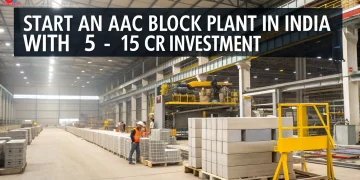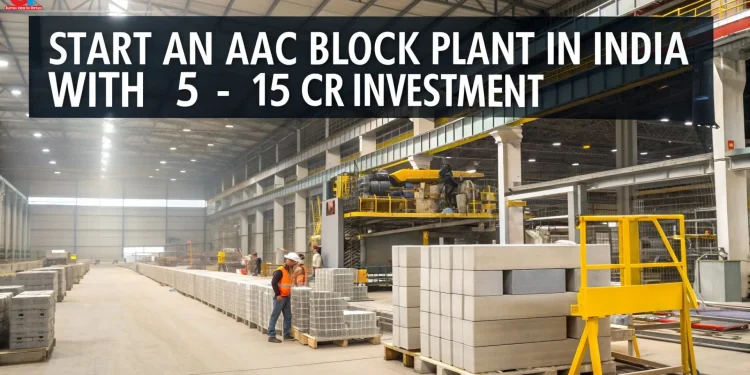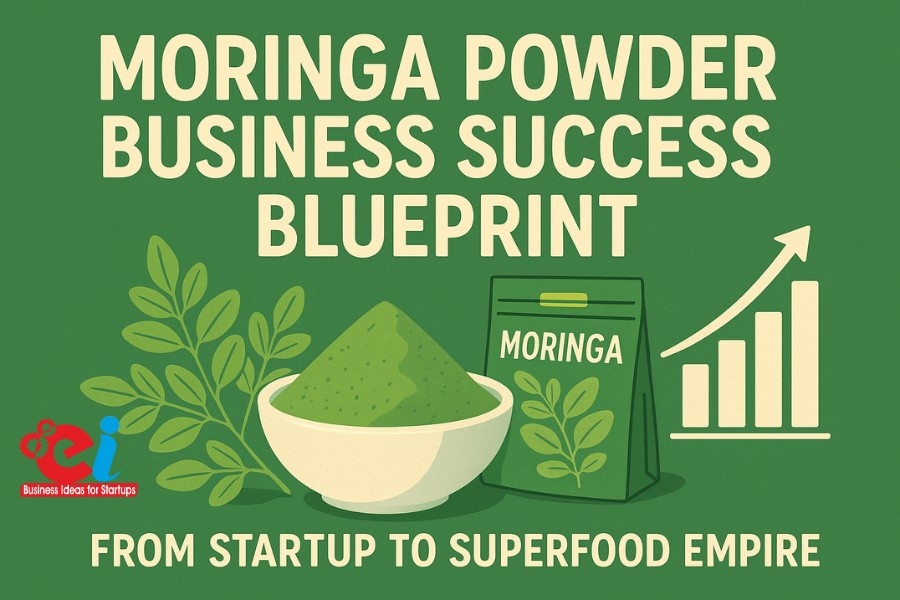The construction sector is experiencing a sharp change. Designs are now paying closer attention to eco-friendliness, faster construction timelines, and reducing costs, leading to the replacement of more traditional materials like clay bricks and RCC structures. This shift has the potential to change the industry for the better, particularly with the introduction of AAC blocks and panels, which have an immense impact on modern construction for residential, commercial, and industrial buildings.
Autoclaved Aerated Concrete, or AAC, isn’t exactly a new innovation. AAC was first developed in Sweden over a century ago, and has seen a rise in use more recently in India and worldwide. As a sustainable construction material, AAC offers many advantages, including its lightweight, being eco-friendly, excellent thermal insulation, fire resistance, and design versatility.
With rising levels of urbanization, AAC blocks and panels are the top choice for architects, engineers, and developers looking to construct smartly and cleaner than ever.
What are Pellets and Blocks of AAC?
Combining fine aggregates, cement, lime, water, and a small quantity of aluminum powder produces AAC blocks and panels. The aluminum powder reacts with the lime to create millions of tiny air bubbles. This mixture is poured into molds and set partially. It is carved into blocks or panels and then cured in an autoclave under high pressure and temperature. This method creates porous, yet solid, AAC blocks and bricks, lighter when juxtaposed with traditional bricks or concrete blocks.
AAC blocks are primarily for wall construction, while AAC panels are precast elements suitable for floors, walls, and roofs. Panels’ primary advantage lies in the speed and uniformity offered to construction, making them ideal for high-rise commercial buildings.
With AAC’s porous structure, both blocks and panels of AAC become insulation, moisture-resistant, and acoustically sound as a suite. Their shape and size being uniform translates into reduced plastering which in turn lowers the construction duration and expenses significantly.
Related: AAC Blocks from Silica Sand & Lime Stone Powder
Pros of Using AAC Blocks and Panels Compared to Conventional Materials
AAC blocks and panels are preferred over clay bricks or traditional concrete blocks due to their lightweight composition. AAC is roughly one-third the weight of its counterparts. This considerable reduction in weight, also referred to as dead load, lowers the structural requirements of the building, which saves money on steel and foundation materials.
Reduced the cost of heating or air conditioning AAC blocks are roughly region-specific foam concrete that offer a greater level of thermal insulation compared to conventional ones. The crude aerated structure of AAC captures air inside the material, which provides insulation.
AAC is extremely fire resistant compared to most conventional materials which makes it ideal for fire-prone zones and safety compliant commercial buildings. AAC can sustain 1,200°C for prolonged periods and can offer fire ratings of up to 6 hours depending on the thickness.
In addition to their thermal insulating properties, AAC blocks also boast highly effective acoustic insulation, reducing sound transmission by up to 40-45 decibels. This feature makes them highly suitable for hospitals, schools, and urban apartment buildings.
From a construction point-of-view, AAC elements have a remarkable ease of handling, cutting and shaping. Furthermore, their use leads to a significant reduction in the use of mortar, as it can be reduced by 60%. The overall speed of construction also improves dramatically. Additionally, buildings constructed with AAC also experience less settlement over time. This further reduces the risk of cracking and structural distortions.
Eco Sustainability and Environmental Impact
In this period of green construction and eco-friendly design, AAC blocks and panels stand out as the most sustainable construction material due to their eco-friendliness. Compared to traditional bricks, AAC blocks are manufactured using a considerably lower amount of energy and natural resources. Not only that, the production also creates almost no waste and has a significantly lower carbon dioxide emission, making AAC blocks the better choice.
The primary raw materials for the AAC include fly ash, lime, cement, and aluminum. These materials can be obtained from industrial byproducts, making AAC blocks a good option for waste minimization and reduction of landfills. For instance, fly ash, which is a waste material from thermal power plants, is a major component in AAC block production, showcasing the idea of industrial symbiosis.
AAC can also be reused and recycled. During the demolition process, the blocks may be crushed and used either as road base or as aggregate in new AAC production. The production and application processes use little water, and buildings made of AAC are often eligible for green building certifications through IGBC or LEED.
Amid these environmental benefits, AAC is being increasingly promoted within green building policies and eco construction guidelines across the globe. Developers using AAC enhance their carbon footprint, but more importantly, they are able to receive government subsidies for sustainable construction.
Cross Sector Uses
The application of AAC blocks and panels is broadening across various types of construction. In residential construction, particularly in urban townships as well as in affordable housing projects, AAC Blocks are commonly used due to their light weight and quick construction speed. They can serve both loadbearing and non-load bearing walls, and their thermal insulating properties makes them ideal for India.
There is an increasing trend of using AAC panels in commercial and high-rise buildings due to their greater uniformity, rapid installation and use in modular wall systems. With the reduced weight of the buildings, architects have more flexibility for the overall design and optimizing the floor space thrusts in the building, reducing the overall building load.
The thermal and sound insulation properties of AAC appeal to warehouses and manufacturing units, while institutional structures like hospitals and schools value AAC’s control of fire safety, as well as its acoustical control qualities.
Developers in the remote locations of a project site for infrastructure development work pre-cast site offices, partitions, low energy cooling systems, and note slabs, and have ascribed AAC technology solutions.
Investment Opportunities in the Manufacturing of AAC
The advancing infrastructure initiatives by the government, in conjunction with the new developments like “Housing For All,” “Smart Cities Mission,” and Atal Mission For Rejuvenation and Urban Transformation (AMRUT) give emphasize on urban infrastructure in metropolitan cities. This poses a unique value proposition and opportunity gaps in meeting the growing need for efficient construction system technology in India. Particularly, the manufacturing of AAC serves as the most promising answer.
Establishing a plant for the fabrication of AAC blocks necessitates an approximate starting capital of 4 to 15 crores, which is contingent with the extent of automation and technology implemented. A medium output plant is capable of 100,000 to 200,000 cubic meters per year to serve local demand.
The location of facilities is crucial. Plants that are located close to sources of fly ash such as thermal power plants have lower raw material costs and logistics expenses. There is strong demand in metropolitan areas, tier-2 cities, and emerging towns, especially where government subsidized residential or commercial property development is underway.
Also, entrepreneurs starting off with AAC production can offer design consultation, turnkey wall setting, and integrated dry-mix mortars, which are supplementary to their primary products, allowing them to stand out in a competitive market.
Related: A Successful Business Idea for AAC Blocks and Panels
Obstacles and Solutions
The growing popularity of AAC blocks and panels comes with the challenge of market education, which is still a hurdle for many builders and masons practicing conventional construction techniques. This knowledge gap can be bridged with training, demo projects, and onsite support.
Much like handling these materials, transportation requires gentle handling given their AAC’s brittleness compared to clay bricks, which requires protective packing to avoid breakage. They also need timely delivery of streamlined supply chain logistics, particularly in remote areas.
To wrap things up, there needs to be some form of standardization and set rules which will more accurately include, respect and integrate, AAC technologies in the construction manuals and urban planning laws. Although the Bureau of Indian Standards has established guidelines for Autoclaved Aerated Concrete, stronger enforcement and increased public knowledge are required to promote its use.
Still, having these challenges does not curb the growing possibilities that Accelerated Aerated Concrete offers. In the view of builders, public sector, and the general populace, where faster construction and improved security along with ecological culture are gaining more attention, AAC building blocks and panels are likely to become a fundamental element of future construction.
Conclusion: Building a Better Future with AAC
The construction landscape is evolving, and AAC blocks and panels are leading the charge toward cleaner, faster, and more sustainable building practices. Their lightweight nature, thermal and acoustic efficiency, eco-friendliness, and compatibility with modern architectural trends make them the building material of choice for the 21st century.
Entrepreneurs, developers, and construction firms who recognize the potential of AAC are not just investing in a product—they are investing in the future of sustainable infrastructure. With growing support from policies, technological advancements, and consumer awareness, AAC is not just an option anymore—it is the future of construction.Let Niir Project Consultancy Services (NPCS) help you with feasibility reports, market research, plant setup consultancy, and investment strategy tailored for your AAC business goals.


























